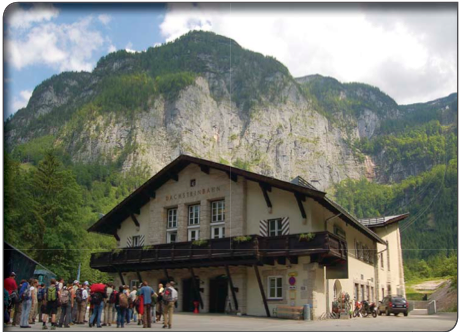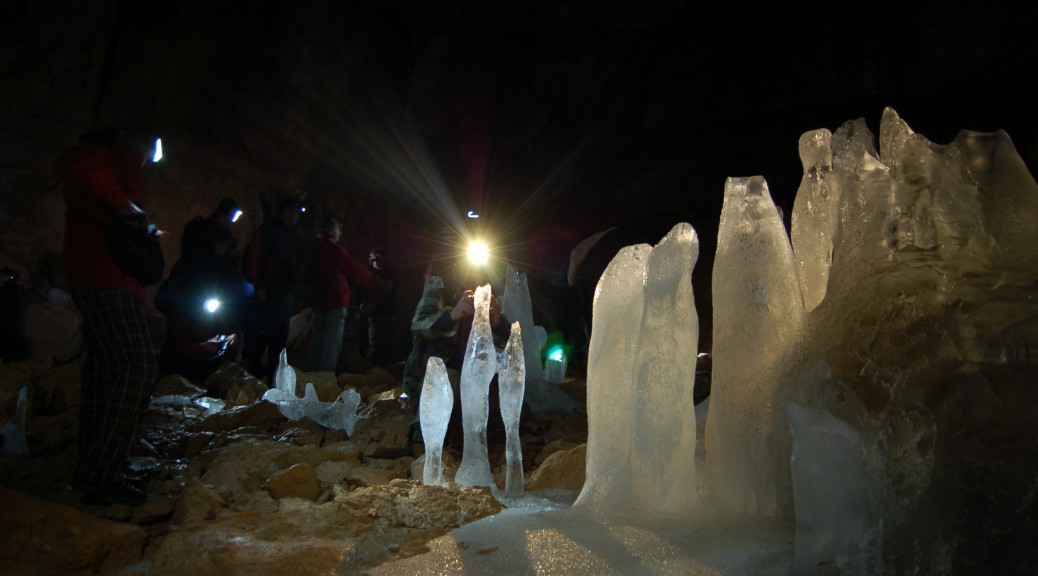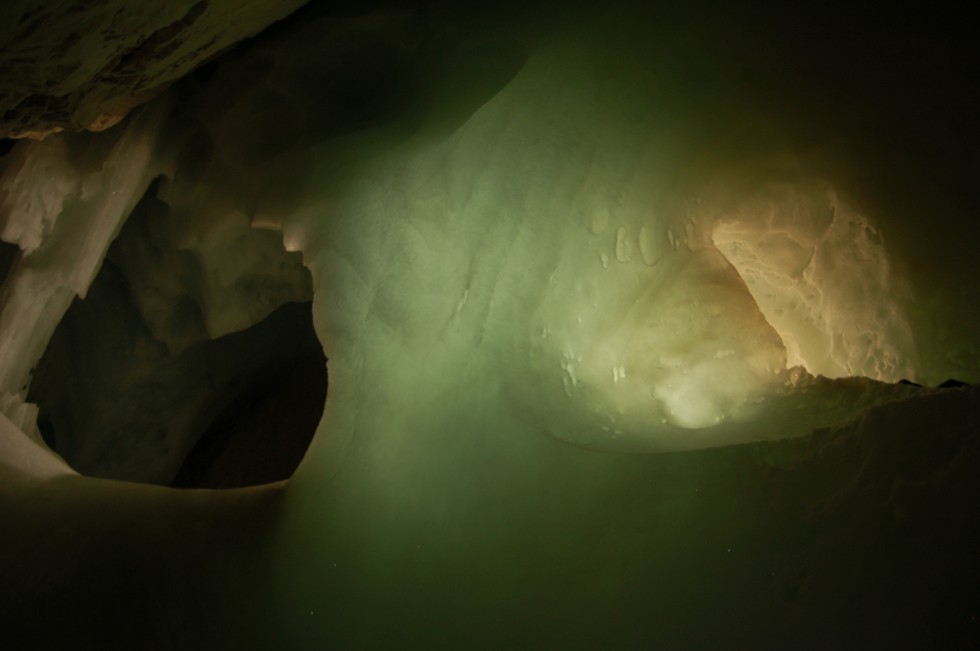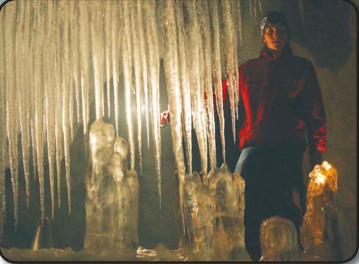It’s early June in the Austrian Alps. Tourists in shorts sweat their way up a trail from the cable car above Lake Hallstatt. But the summer heat doesn’t stop a group of scientists from pulling on brightly colored jumpsuits over their hiking clothes at the entrance to Mammuthohle, one of the many limestone caves that riddle the Dachstein Massif. Lukas Plan, a geophysicist at the University of Vienna, straps on his headlamp and pauses to warn the crowd of researchers about the cave they are about to enter. It won’t just be chilly inside, he cautions; it will be an Alpine meat locker.
The crowd, part of the fourth international ice cave workshop organized by a network of European geophysicists and glaciologists, is gathered to visit the cave’s year-round ice formations.
Plan turns toward the tunnel in the mountainside and opens the metal door. A rush of wind bursts out. The group prepares to enter, hoping to read the history of the region’s climate in the cave’s ice.
Paleoclimatologists often turn to ice cores drilled from glaciers or ice sheets in Greenland or Antarctica. And like glaciers and polar ice caps, “ice caves are just one of several peculiar phenomena that show a reaction to climate,” explains glaciologist Stephan Gruber of the University of Zurich in Switzerland and an editor of the journal The Cryosphere. “A lot of people who do analyses on ice cores are quite keen to also analyze samples from ice caves,” he says.
Somewhat sparse research over the past few decades has shown that ice in temperate caves holds similar and complementary secrets to ice else- where. Because it’s a new field, however, researchers are still trying to figure out how to use cave ice as a climate record: Its complex formation history makes it less straightforward to study than polar ice. But when unlocked, the secrets in ice collected from caves in temperate regions allow climatologists to study the effects of global climate cycles in places where people actually live, such as Obertraun, Austria, where last summer’s cave excursion took place.

The cave next door

Since the first international ice cave workshop in Capus, Romania, six years ago, a core group of 35 to 50 researchers has met biannually to catalog caves and compare notes. So far, they have traveled from New Mexico to Italy to Russia to study centuries- to millennia- old cave ice.
The cave ice can take the form of giant icicles, looking much like stalactites. Or it can build up from the cave floor, as stalagmites do. Or it can pool and build massive, dirty ice cubes. All of these forms offer clues to a cave’s past climate, locked in layers of dirt, minerals and ice.
Because caves with ice are found in otherwise temperate climates where year-round ice — much less ice enduring millennia — is not expected, they must have special properties, geologists reason. Somehow the ice remains outside the annual tumult of the water cycle, preserved in an eddy of geological time.
“First of all, we have to understand how the ice caves work,” says Valter Maggi, a glaciologist at the University of Milan-Bicocca in Italy. “We have some caves with ice, and other caves at the same altitude or position without ice,” he says, while tramping through Mammuthohle. Researchers don’t know why, and he adds, they don’t know much about what is normal and what isn’t in ice-bearing caves.
Thus far, researchers have found that cave ice forms in many ways. In Austria, some mountain caves, such as Mammuthohle, have multiple entrances at different heights on a mountainside, generating a flow of cool, sinking air inside the cave. If the air moves quickly enough, it can freeze dripping or standing water, trapping clues about the outside weather at the time the water entered the cave. In Croatia, however, at Nestasna jama — a 105-meter-deep pit cave in the Dinaric Mountains — the process is different. There, a sinkhole with a shaded, vertical shaft entrance accumulates snow and cold air during the winter. During the rest of the year, any warm air that finds its way into the cave can rise up and escape, allowing the cave to sustain freezing temperatures on the inside. Any water that trickles in will freeze, thanks to the perennial cold. Other ice caves hint at even more formation processes, which researchers are only beginning to understand, Maggi says.
The next paleoclimate frontier, next door?

Ice is a great record of past climates because water contains a signature ratio of oxygen isotopes that changes from year to year. A wet year, a dry year, a cold year or a warm year each has its own signature. Glaciologists like Maggi have exploited these variations in ice cores from Greenland and Alpine glaciers. They have matched the variations against other indicators of the global climate history going back nearly a million years.
Glaciologists can use cave ice records in a similar manner. And if cave researchers can work back- ward from the layers of ice they find in caves to the conditions at the time the ice formed, they will be one step closer to understanding global climate change on a smaller scale, to see how it affects individual sites. “Let’s say we see a temperature drop at 500 years ago [in Mammuthohle]. Can we see the same temperature drop around 500 years ago elsewhere in Europe?” asks Aurel Perșoiu, a geology doctoral student at the University of South Florida in Tampa.
Once researchers have a temperature record from ice cores, they can compare cave ice clues to other climate proxies. Pollen trapped in lake sediments or glacial ice, for instance, reveals how climate affected forest cover at a certain time. Researchers can also use radiocarbon dating to pin down the pollen’s age. And some cave ice researchers think it may be possible to extract complementary information about past winter seasons from cave ice, much like tree ring thickness reveals the relative length of growing seasons from year to year, Gruber says. Yet another point of comparison between cave ice and other proxies is the ratios of isotopes in speleothems such as small calcite stalagmites, says Stein-Erik Lauritzen, a geologist at the University of Bergen in Norway.
Perșoiu and company have a lot of grunt work to do in figuring out just how ice accumulates in caves before they can reduce each cave’s complex history to a data point on a map though. Ice from Nestasna jama tells a different story from ice in wind tunnel caves like Mammuthohle, because each cave can host wildly variable conditions. What if some old ice melts away for a few years before new layers form, for example? What if ice blocks a windy tunnel, preventing it from cooling an icy chamber?
What can we learn?
These questions are on researchers’ lips during the Mammuthohle excursion that is part scientific workshop and part scientific tourism. Once in the cave, the crowd files along a paved path inside a dry limestone tunnel, headlamps bobbing wildly as they look around. In one chamber, Plan shows an example of the kind of changes cave ice can undergo. A thin wall of ice stands like translucent sheetrock at a construction site. A stream of warm air is melting its way through the wall, creating a circular hole. Ice covering the top of the hole, visible in photos from previous visits, is missing. One caver leans up against the ice with her headlamp and stands stock still, illuminating it. Another caver leans against a rock and takes a long exposure with a camera in the silence, preserving what’s left of the wall in digital form.

The disappearance of cave ice from the stratigraphic record, even if more ice accumulates in subsequent years, makes some scientists skeptical that it will ever be a serious climate history proxy. “I’m not really optimistic about getting a continuous record since there have been times when there was no ice in these caves,” says Dietmar Wagenbach, an environmental scientist at the University of Heidelberg in Germany, who attended the excursion. But, he notes, the very absence of new ice says something about the climate at those times as well. “This is an important signal … but you can only give this answer if you have a dating tool” for the ice surrounding the gaps in the record, he says.
Barbara May, a graduate student at Heidelberg working with Wagenbach, has tried to do just that with an ice core from the Eisriesenwelt cave, another ice cave in Austria. May drilled into the ice in 2007; on her first attempt, she could not link the visual changes she observed in her core’s layers to other climate records. She tried finding the age of small organic inclusions in the core using carbon-14, but that did not work either. “We only have the records against depth, not against age,” she says. “We’re trying to date the core, but it’s resisting.”
Shifting, changing ice
Collecting data in icy caves is no easier than analyzing it, but it’s a necessary evil if researchers hope to learn how cave ice forms and is preserved. The last stop of the tour in Mammuthohle reinforces how sensitive cave ice is and the need for understanding it better. Plan, who until then had simply walked up and down the line of visitors like a schoolteacher on a field trip, asks a couple of helpers to set up a pair of ladders and ropes. The group then shuffles along the top of an ice bulge to the ladder, which everyone climbs to get a close-up look at the stratigraphy in the ice.
At the top, mud mutes the ice’s colors, but away from the edge and the ladder, alternate layers of blue and white from different crystallization pat- terns appear. Thin layers of calcite give the ice block a gritty feel. As cavers climb down the ladder, Plan says from his rocky perch below, a few meters away from the ice wall, “The place where I’m standing, I think 20 or 30 years ago you could walk on the ice.” Knowing that the state of the ice is so variable is just one piece of the puzzle — it would be tempting to say that warmer outside temperatures are responsible, but as Plan and the other cave visitors know, the caves’ own microclimates could moderate the effects of the outside world.
Despite the challenges, Nenad Buzjak, a geographer at the University of Zagreb in Croatia, can sometimes be found with a laptop deep inside one of Croatia’s caves, dodging dripping ice. He plans to examine nearly 50 caves known to contain ice and snow, map them, study their interior climate, and measure the quantity and dynamics of the ice inside them. He’ll need that information to understand the relationship between the amount of energy moving in and out of the cave in the form of heat and wind and the formation or melting of ice inside. It’s a crucial step for anyone intent on reverse-engineering what ice in today’s caves can say about the past climate inside the cave.
Another key step will be trying to characterize the relationship between the outside weather and the weather inside a cave. Bulat Mavlyudov, a geographer at the Institute of Geography within the Russian Academy of Sciences in Moscow, has been trying to tabulate weather ’s effect on caves in the Ural Mountains in Russia using eyewitness reports and scientific measurements dating to 1703. The tables include the angle of the cave entrance, its altitude and latitude, and how much ice it has contained over the years, which can be compared to weather records. But, he notes, “we have a problem of drawing global conclusions from a few examples.”
In addition, says geophysicist Marc Luetscher of the University of Innsbruck in Austria, “monitoring caves and getting their ice mass history is inefficient because there is so much variation between caves and the way they have been measured. … But maybe we can model the relation between local weather and ice instead, from the few we know.” He and others are trying to create equations that use a cave’s shape, air flow into and out of the cave, and temperatures at the entrance and inside the cave to predict how much ice should build up or melt under various circumstances. But verifying the accuracy of such models could be slow going. “Even if we build these models, the next step is to test them by waiting around 10 years,” given that there are no climate models with high enough resolution to predict the weather outside a cave entrance, says Friedrich Obleitner, a glaciologist also at Innsbruck who is also involved in Austrian ice cave surveys.
Cave results, at a glacial pace
Cave ice may still be considered a sideshow in the circus of climate science, but useful results are beginning to accumulate.
A team led by Perșoiu submitted results from a 2,000-year-old ice core from Scărișoara, Romania, to the Journal of Geophysical Research not long after the expedition to Mammuthohle. The researchers used organic objects buried in cave ice, such as parts of trees, to estab- lish an estimated age-depth relationship for the ice and then calculated the age of the deepest ice. Other teams are using similar dating approaches. A Danish team led by now-retired Greenland ice core specialist Henrik B. Clausen from the University of Copenhagen dated ice in a Slovakian cave to A.D. 1357 by radio- carbon dating a bat preserved in the ice. These cave ice dates are much younger than polar ice cores, but still useful for improving our understanding of recent climate patterns, Luetscher says.
In St. Livres cave in Switzerland, Luetscher and some Swiss colleagues have used radiocarbon dating of pieces of spruce trunks and branches in a snow and ice outcrop to assign ages to seven corresponding layers of ice, spread over 1,200 years. Then they identified layers that sug- gested strong snow accumulation and gaps during which little or no snow accumulated. Parts of the pattern matched one well-known climate system: the North Atlantic Oscillation (NAO). Several gaps in the St. Livres ice matched warm periods in the NAO. But another gap had no match in the NAO. In a 2009 paper in Quaternary Research, Luetscher and his colleagues explained the anomaly by citing historical records of locals who shoveled out some snow and ice from the cave during that gap.
By seeking out such a sensitive climate archive close to inhabited areas, these researchers may be on the bleeding edge of paleoclimatology. Cave ice isn’t a perfect climate record — the ice can melt or the locals can shovel it out, and the weather can change, preventing new records from forming or erasing old ones — yet it may someday follow in the intellectual footprints of other natural archives, each of which had its skeptics before achieving widespread adoption as a climate proxy.
Difficulty of collecting cave ice data
Collecting data in icy caves is no easy task. In Eisriesenwelt cave in Austria, Barbara May, a graduate student at the University of Heidelberg in Germany, found that she couldn’t just borrow glaciology equipment and tunnel into a cave. For starters, the temperature is wrong: Caves tend to hover around freezing. When May and her colleagues fired up their cor- ing drills in 2007, the heat from the drill melted ice just long enough to refreeze it, jamming the drill. The team tried lubricating the drill with alcohol, but they worried that the lubricant could interfere with the chemical analysis of the core. None of this is a problem on glaciers, which tend to preserve colder temperatures beneath their surfaces.
Valter Maggi, a glaciologist at the University of Milan-Bicocca in Italy, and his colleagues have encountered similar logistical challenges. During one expedition to the Abisso sul Margine dell’Alto Bregai in the Central Italian Alps in 2000, they hit rocks embedded in the ice 1.2 meters deep, preventing them from obtaining a full ice core. They tried again in 2003 and encountered the same problem at 5.1 meters. They published their initial results in 2004 in Theoretical and Applied Karstology.
“Ice coring by hand is slow,” Maggi explains, and generators to power electric drills are heavy and hard to transport. Researchers also can’t stay in the caves too long. “Maybe it is a paradise for scientists, but it is a hell for cavers because it is freezing cold and you are always looking at ice blocks above your head,” jokes Nenad Buzjak, a geographer at the University of Zagreb in Croatia, while describing his own field work at the workshop in Obertraun.

This feature, including photos, first appeared in EARTH Magazine: [pdf].




